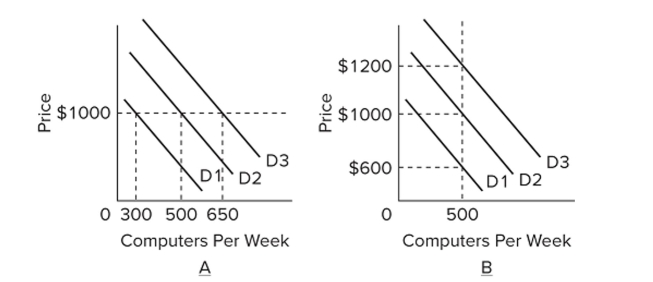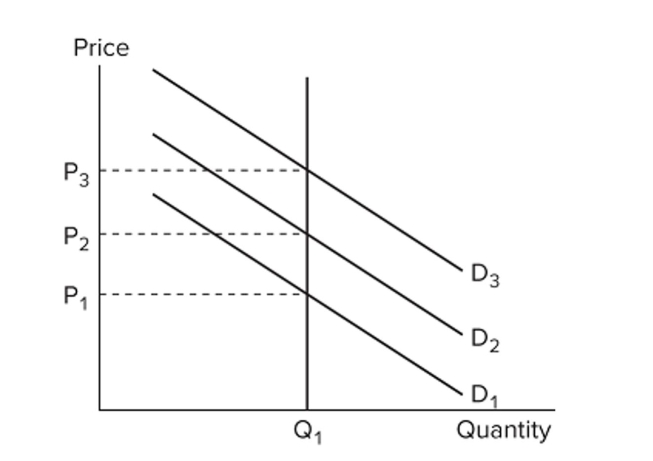Correct Answer

verified
Correct Answer
verified
Multiple Choice
If a family's income doesn't change, but inflation is 3.5 percent, then the
A) family will need to spend more in order to maintain its standard of living.
B) family will need to spend less in order to maintain its standard of living.
C) family's standard of living is not affected by inflation.
D) family will need to spend the same amount in order to maintain its standard of living.
Correct Answer

verified
Correct Answer
verified
True/False
Economists use different models of the economy because the economy behaves differently depending on how much time has passed after a demand shock.
Correct Answer

verified
Correct Answer
verified
Multiple Choice
 Refer to the graphs. Suppose a firm is currently producing 500 computers per week and charging a price of $1,000. How will the firm respond to a positive demand shock if prices are inflexible?
Refer to the graphs. Suppose a firm is currently producing 500 computers per week and charging a price of $1,000. How will the firm respond to a positive demand shock if prices are inflexible?
A) The firm will increase production to 650 computers per week and charge a price of $1,000.
B) The firm will continue to produce 500 computers per week and charge a price of $1,000.
C) The firm will cut production to 300 computers per week and charge a price of $1,000.
D) The firm will cut production to 300 computers per week and charge a price of $600.
Correct Answer

verified
Correct Answer
verified
Multiple Choice
(Consider This) The U.S. recession that occurred in 2008 and 2009 represented a case where
A) government policy intervention effectively offset the negative demand shock and minimized the effects on output and employment.
B) prices were somewhat flexible, so the impact of the demand shock was felt about the same in terms of price and output changes.
C) prices were relatively flexible, minimizing the impact on total output and employment.
D) prices were relatively sticky and most of the impact was on total output.
Correct Answer

verified
Correct Answer
verified
True/False
Price stickiness tends to moderate over time.
Correct Answer

verified
Correct Answer
verified
True/False
Economic growth defined as rising GDP per person has occurred since the Roman Empire (approximately 2,000 years ago).
Correct Answer

verified
Correct Answer
verified
Multiple Choice
Macroeconomics is primarily concerned with studying two broad topics:
A) long-run economic growth and short-run business cycles.
B) the price of oil and gas abroad and prices of energy in the domestic market.
C) the stock market and the housing market.
D) household incomes and firms' profits.
Correct Answer

verified
Correct Answer
verified
Multiple Choice
If prices are "sticky" in the short run, then
A) the economy will respond to demand shocks primarily through changes in output and employment.
B) the economy will respond to demand shocks primarily through changes in prices and inflation.
C) prices will adjust to equalize the quantities demanded and supplied of goods and services.
D) unemployment will not change in response to a demand shock.
Correct Answer

verified
Correct Answer
verified
True/False
In order to achieve modern economic growth, a nation's output must grow faster than its population.
Correct Answer

verified
Correct Answer
verified
Multiple Choice
In earlier centuries, the Roman and Chinese economies
A) expanded in such a way that output per person increased.
B) expanded in such a way that output per person decreased.
C) declined in such a way that output per person decreased.
D) expanded, but output per person remained virtually stagnant.
Correct Answer

verified
Correct Answer
verified
Multiple Choice
Why are economists concerned about inflation?
A) Inflation generally causes unemployment rates to rise.
B) Real GDP is necessarily falling when there is inflation.
C) Inflation lowers the standard of living for people whose income does not increase as fast as the price level.
D) Inflation increases the value of people's savings and encourages overspending on goods and services.
Correct Answer

verified
Correct Answer
verified
Multiple Choice
Which of the following is most likely to indicate higher unemployment?
A) an increase in real GDP
B) an increase in nominal GDP
C) a decrease in real GDP
D) a decrease in nominal GDP
Correct Answer

verified
Correct Answer
verified
Multiple Choice
Today, living standards in the richest part of the world are
A) about five times higher than living standards in the poorest parts of the world.
B) about 50 times higher than living standards in the poorest parts of the world.
C) about the same as living standards in the poorest parts of the world.
D) expected to double every 10 years.
Correct Answer

verified
Correct Answer
verified
Multiple Choice
Modern economic growth refers to countries that have experienced an increase in
A) real GDP over time.
B) nominal GDP over time.
C) real output spread evenly across all sectors of the economy.
D) output per person.
Correct Answer

verified
Correct Answer
verified
Multiple Choice
Price wars among firms
A) tend to reduce short-run price stickiness because firms know they can lower their own prices without rival firms lowering their prices.
B) occur when one firm lowers its price and rival firms react by lowering their prices.
C) occur when firms use advertising to take customers away from rival firms.
D) have no effect on the degree of short-run price stickiness.
Correct Answer

verified
Correct Answer
verified
Multiple Choice
If prices of goods and services were free to quickly adjust, then
A) a negative demand shock would lead to increased unemployment in the short run.
B) a positive demand shock would lead to increased unemployment in the short run.
C) a negative demand shock would have no short-run effect on unemployment.
D) there would be no short-run demand shocks.
Correct Answer

verified
Correct Answer
verified
Multiple Choice
 The figure depicts a situation where
The figure depicts a situation where
A) prices are sticky, but output is flexible.
B) prices are flexible, but output is constant.
C) prices and output are both flexible.
D) prices are sticky and output is constant.
Correct Answer

verified
Correct Answer
verified
Multiple Choice
If prices of goods and services quickly adjusted to demand shocks, then
A) firms would find it difficult to produce at their optimal output rates.
B) output rates would quickly adjust to changes in demand.
C) firms would find it easier to produce at their optimal output rates.
D) the economy would experience severe short-run fluctuation.
Correct Answer

verified
Correct Answer
verified
True/False
Increasing investment in the present means forgoing future consumption.
Correct Answer

verified
Correct Answer
verified
Showing 201 - 220 of 243
Related Exams